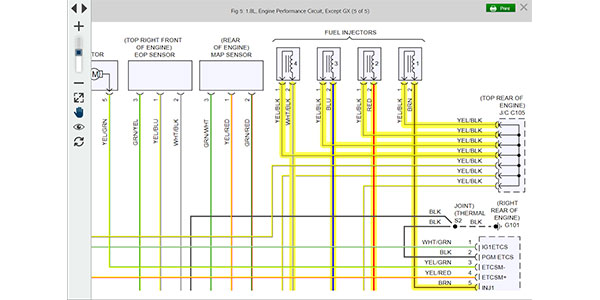By Andrew Markel
Editor
BRAKE & FRONT END
It has been estimated by one ride control manufacturer that 80 percent of vehicles in junkyards still have their original shocks or strut units. Part of the reason is that selling shocks and struts is difficult. It is an item that when it wears, it does not cause the vehicle to stop running. When it does wear, the driver is usually not aware of how bad it really has become. Also, replacement can be expensive if the vehicle has struts at all four corners. But, it is an item that can make a distinct difference in vehicle performance that the customer will really appreciate if replaced.
Often, you are your own worst enemy when selling ride control. It happens to most salespeople, over time they become apathetic to selling ride control products to the customer. It is a cycle with three phases.
It all starts with a few rejections by customers to buy shocks and struts. This builds up a subliminal callus that makes the salesperson hesitant to sell shocks and struts. This callus builds up because no one likes to fail or be rejected. It is why some people find asking the opposite sex out on a date so difficult. The salesperson will start down this road that eventually leads to lower sales and decreased job satisfaction.
The second phase of this cycle starts with just listing the recommendation and estimate for shock or strut replacement on the bill and maybe mentioning it casually to the customer during the sales process. This means that the sales person will invest very little time, effort and emotions. The recommendation becomes more of a “feeler” question rather than a real sales proposal.
The third phase starts when the salesperson starts second-guessing if they should even write the estimate on the repair order at all. They may base their guesses on stereotypes and assumptions. But, chances are they are wrong.
The last phase is the most destructive to sales. This is where the salesperson rationalizes that the time spent trying to sell the customer ride control can be used for easier items that are guaranteed to sell. This is not only a great disservice to the shop, but it is a greater disservice to the customer.
To end the cycle it takes mental and physical tools to break this self-defeatist cycle. Also, turning this apathy into enthusiasm requires a methodical approach that goes further than incentives like vacations, point systems or t-shirts. It requires a proper inspection of the vehicle and communications with the customer.
INSPECTION
The first step in selling ride control is the inspection process. A visual inspection of the shocks and struts can tell you a lot about the state of the ride control units. If possible, visual inspections should be performed before the testdrive. This is a chance to make sure the vehicle is road-worthy before you put your own life at risk. Also, always make sure that there is enough gas in the tank.
Look for the signs that the units might be leaking oil. Accumulations of road grime or oil present inside boots and dust shields are signs. Keep an eye out for “witness marks” that indicate the suspension might have bottomed out recently. Make sure all bushings and hardware for the ride control units are still on the vehicle.
Walk around the vehicle and perform the tried-and-true “knee-on-the-bumper” test. The test is not conclusive on its own. However, it is a chance to look for abnormal behavior. If you notice binding or looseness or if the vehicle does not return to the original ride height, it could be a sign that there is a problem with the ride control components. If you want to go the extra mile, measure the ride height from side-to-side. This measurement can be taken from the top of the wheel arch to the floor. This can help to clue you onto weak or broken spring.
When going for a testdrive, you should have a clear objective and methodical plan for inspecting the vehicle for ride control replacement and other unperformed repairs. Before going on a testdrive, you should have a clear list of symptoms and related conditions the customer might be experiencing.
A good test driver will be able to observe conditions or problems with the vehicle that have developed so slowly the owner is unaware of them– like degraded shocks and struts. One of the keys to becoming a good test driver is to find a driving “loop” or route that has a variety of road conditions. Using a predetermined loop can help to build consistency that will help you to spot small problems.
For suspension road tests, your test loop should consist of sections: a flat and straight section; an area to test braking and acceleration; an area with a dip or bump; and an area that offers both left and right turns.
On the flat and straight section of the loop, test directional instability and observe steering wheel position. The road surface should be smooth and flat with very little crown. The objective is to drive on a surface that will not influence the direction of the vehicle. This can also be a way to spot weak springs and ride height problems. Use a parking lot or rarely used section of road for this section of the test. This test is used to detect brake pulls, torque steer and worn or loose suspension or steering components. Check for excessive nose-diving during braking. This is not normal and may be caused by worn springs or ride control. Worn springs will affect vehicle ride height and may affect overall vehicle handling.
Drive the vehicle over the bump or through the dip and observe the steering wheel position. This is an excellent test to detect weak springs, weak shocks and worn or unlevel steering components. If the vehicle changes direction or the steering wheel moves excessively, the steering components may be worn, incorrectly adjusted or unlevel. Excessive suspension bouncing may be the result of weak shocks.
Bottoming out of the suspension may be the result of weak springs. Check for steering difficulties that may be the result of mechanical binding or interference. This condition is commonly referred to as “memory steer.” Check for proper returnability of the steering wheel after a turn. Excessive driver effort might indicate worn or damaged strut mounts or ball joints.
Any excessive body sway could indicate worn springs, shocks or stabilizer assemblies. Listen for any excessive squealing of tires during turns. This can be caused by incorrect alignment settings or turning angle out of specifications.
Developing a methodical and consistent testdrive loop and procedure can improve your chances of coming back from a testdrive with a better understanding of the problem the owner is experiencing. Also, having a plan and a loop can eliminate distractions that could lead to an accident.
The technician should be supplied with a checklist to make notes. Some ride control manufacturers can provide you with printed forms. These forms can help the salesperson be more confident in the selling process.
COMMUNICATION
A complete inspection lays the groundwork for excellent customer communications and increases the possibility of a sale. The results of the inspection can help personalize the sales pitch to the individual customer.
The following is an example of how a note on an inspection form can provide so much more than a simple “recommend new shocks and struts.”
Salesperson: “On the testdrive, the technician noticed excessive nose dive during braking and increased body roll while turning. Also, we noticed humming coming from the rear that was caused by uneven wear of the rear tires.”
Customer: “I guess it is not exactly performing the same as it was when new and that humming noise was starting to annoy me.”
Salesperson: “New struts can help to return the vehicle to like it was when it was new. Also, they can prevent future uneven wearing of your tires.”
In this simple interchange of information, the information gained in the testdrive helped to identify and define the value of new ride control components to the customer. Also, the information given to the customer helped to create a tangible need that they can relate to on why the service should be performed. All of this was done without going into techno speak.
Even if the customer does not buy today, this sales approach and pitch will likely stick with the consumer longer than the generic “recommend new shocks and struts.” This means that they might be back and your efforts will not be in vain.
SALES TOOLS
Information on the benefits of replacing ride control can be found by reading trade magazines, but one of the best sources of information is the ride control manufacturers. Almost every ride control manufacturer has developed a program that can help in the sales process. These programs go beyond box-top redemption promotions and store signage. These carefully designed programs can provide you with training materials like books and DVDs for technicians and salespeople. Also, they can provide you with brochures that can be given to the customer.
Some ride control manufacturers are helping you by holding local clinics where you can drive vehicles in different states of ride control degradation. These events are typically held in parking lots on specially designed courses that magnify the certain vehicle dynamics at low speeds. These events can help to energize your staff to sell ride control products more effectively.
As stated previously, selling shocks and struts is not easy. If a salesperson can be confident in his sales procedure and information he can present the customer, he can take the worst rejection by a customer in stride. The way to build this confidence is through a defined effort that involves everyone in the shop.






